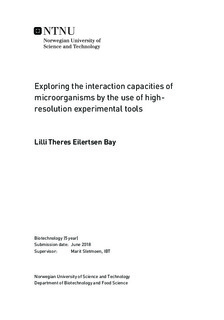| dc.description.abstract | Cells of Saccharomyces cerevisiae poses a possible detoxification method for the removal of mycotoxins through the formation of a yeast-mycotoxin complex. One of the main fungal genus that produces mycotoxins is the Fusarium, where fumonisin B1 is considered to be the most toxic. Fumonisin B1 is a carcinogen, predominantly found in maize- and maize based animal feeds. This study aims to characterize the ability of S. cerevisiae to interact with fumonisin B1, as well as to elaborate on the molecular mechanism involved in the yeast-fumonisin B1 complex formation.
The adhesiveness of S. cerevisiae was investigated using optical tweezers and shear stress flow chamber. The optical tweezers enables measurement of forces in the range of 0.1-200 pN, while the simple setup of the flow chamber offers measurements within a widely applicable force range. It was discovered that viable BY4741 and mutant mnn9 cells of S. cerevisiae were not able to interact with fumonisin B1. The outer mannan-layer of the cell wall was concluded to not participate in an interaction with fumonisin B1. Furthermore, reducing the mannan-layer did not improve the adhesiveness and it was thus considered to not limit the access to the adsorption sites. An interaction frequency of 16% was recorded between beta-glucan and fumonisin B1, in which the structure of beta-glucan was considered to affect the ability to interact with the mycotoxin molecules. Heat treated BY4741 cells presented an improved adhesiveness, where the treatment was assumed to alter the cell wall structure which promoted the availability of the adsorption sites. The lack of a negative control is at present a limitation that that entails challenges related to verification of the reliability of the obtained results.
Investigating cellular adhesion at the single cell level is important for detecting cell heterogeneity. This focus on detecting cell heterogeneity has lead to the development of new methods for single cell analysis, such as microcontact printing. Another objective of this thesis was to investigate the use of microcontact printing in order to produce a microoarray of S. cerevisiae cells on a PLL patterned glass surface. A PDMS stamp with micrometer scale features was successfully fabricated and used to deposit a pattern of fluorescent PLL onto a glass slide. However, within the limited time period available, S. cerevisiae was not successfully immobilized on a PLL-functionalized surface. | |

